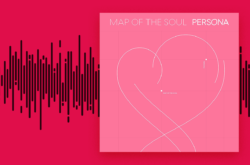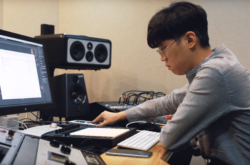Photo illustration: Celina Pereira
I’d like to think a universal goal among artists is to make timeless music.
That said, the landscape of popular music is one that’s constantly shifting—tastes change with age, social climates, current events, and more. To stay on top of things, artists and producers are either starting a trend or catching the tail end of the wave.
Over the last few years, K-pop has steadily gained attention in the discourse of ‘genre trends.’ However, K-pop isn’t just a genre; it’s a culture. It can’t be distilled to a handful of distinct sounds or production techniques. Rather, it’s a complex world that navigates arrangement, storytelling, performance, and the constantly evolving interpretation of pop music.
For this reason, talking about the evolution of production across K-pop as a whole is far too broad and doesn’t quite make sense. So, I want to focus this piece on the change in production decisions over time for one single group—BTS. There are countless articles about their global domination and the west’s adoption of K-pop music in the mainstream. But, I always struggled reading descriptions of ‘the K-pop sound,’ or how readily some articles wanted to group any Korean artist as ‘K-pop.’ Because what is a ‘K-pop sound?’
The western music industry has had a complex relationship with genre. On one hand, it’s critical to recognize that music is rooted in culture, and many genre labels are a meaningful acknowledgement to a rich history. But at the same time, genres can be misused to appropriate cultures, box in artists based on their ethnicity, and leave little room for experimentation or evolution beyond unfair stereotypes and expectations.
If pop and K-pop share their defining sonic characteristics as ones that blend different genres and move people through music, then the discography of BTS can provide us an opportunity to reflect on various interesting shifts in music’s soundscape over the last several years.
For simplicity, I’ve organized their discography into three periods. The parallels drawn compare their discography with the trends happening in the United States around the same time periods.
2 Cool 4 Skool – Dark & Wild (2013 – 2014)
When they made their official debut in 2013, BTS was introduced to the world as a hip hop idol group. Tracks like “We are Bulletproof Pt.2” and “No More Dream” from their debut album 2 Cool 4 Skool demonstrate BTS’ early dedication to hip hop elements. Their vocal performances are aggressive, determined, and tinged with a sense of urgency. There are horn accents, 808s, percussive gun effects, sirens, and background chants. In “We are Bulletproof Pt.2,” we hear pitched-up string loops used as lead melodies, sped up and paired with a boom bap drum beat.
Quickly following was Dark & Wild. In this album, there are still strong hip hop elements, which are now combined with more punk rock influences. In the track “Danger,” a brief beatbox intro is followed by distorted electric guitar stabs, layered with synths and chopped vocals. In the pre-chorus, Jin’s emotive vocals are accompanied by sparkly chimes and a strings section, adding a soft and unexpected contrast to the track. Then, in the breakdown before the next verse, the rock guitars receive a solo moment.
“Danger” didn’t have much commercial success in comparison to other songs, despite blending many unique elements and being such a high-energy track. The blend of rock and hip hop may have been true to BTS’ story at the time, but 2014 was also when Gene Simmons infamously announced in an Esquire interview that “rock is dead.” Even in the years prior, popular music in the west was starting to drift away from the singer-songwriter style of rock-pop. EDM was permanently embedding itself in the DNA of popular music production, hip hop was becoming more popular with mainstream listeners, and funk and disco elements started re-entering the conversation.
For reference, below were some of the most popular songs in the U.S. during that period, which all incorporate some of those elements:
- 2011: “Party Rock Anthem,” “We Found Love,” “Headlines”
- 2012: “We Are Young”
- 2013: “Blurred Lines,” “Get Lucky,” “Suit & Tie,” “Happy”
- 2014: “All About That Bass,” “Fancy,” “Bang Bang”
With that in mind, funk, R&B, disco, and even Latin pop elements are present in some of the other early releases of BTS. “Just One Day” evokes a typical R&B ballad, featuring an organ, classic synthesizer chords, and soft vocal ad-libs. “Look Here” has a catchy guitar loop, funk grooves, and sultry vocals that feature both classic falsettos and vamps. “2nd Grade” exemplifies the genre blending of BTS production at its core, blending 808s, pitched synth plucks, video game sounds, and doo-wop guitar strums; the structure of the song and its production remind me of Fergie’s “Clumsy” in 2007.
2013 – 2014 saw the freshman and sophomore releases of BTS, and demonstrated their vocal prowess and the production team’s ability to mix elements from many different genres into cohesive tracks. At the time, BTS was still discovering their sound and their stories, and reflecting within themselves. The development is apparent as they released their second official album, Wings, which we’ll get to in a moment.
The Most Beautiful Moment in Life – Love Yourself (2016 – 2018)
In 2015 – 2016, the world saw Jack Ü (Skrillex and Diplo), Marshmello, Zedd, The Chainsmokers, and DJ Snake topping the charts with EDM synth-heavy dance music, with notable hits such as “Where Are Ü Now,” “The Middle,” and “Closer” seizing air time. These tracks incorporated vocal leads, vocal chops, synths, and a lot of saw waves.
Meanwhile, during those same years BTS fans received a special series of releases, The Most Beautiful Moment In Life. “Fire” and “Dope” reflected the latest popular production styles, featuring blaring siren synths, high-energy stacked vocals, and horn leads. Similarly, on “I Need U,” “Save Me,” and “Run,” we saw BTS’ departure from their sound being primarily centered around hip hop.
Their second official studio album, Wings, followed shortly after. On “21st Century Girl,” we hear a similar EDM-based structure with build-ups, drops, synth stabs, and a call-to-action hook involving the classic “put your hands up” line.
With Wings, it’s clear that each song was written with grand gestures and theatrical performances in mind. The energy across the tracks is more disciplined, revealing tremendous growth in respect to how both the members and producers approach their work. Throughout the album are subtle uses of classic synthesizer keys, dramatic strings sections, and a more artful blend of production styles than ever in a seven-threaded narrative. Their newfound breadth is apparent in tracks like “Awake,” “MAMA,” and “Lie.”
Their next full-length album to follow Wings was Love Yourself 轉 ‘Tear’ in 2018, which followed the EP Love Yourself 承 ‘Her’ and preceded the compilation album Love Yourself 結 ‘Answer.’ These releases featured their first collaborations with the likes of Steve Aoki (on “MIC Drop” and “The Truth Untold”) and The Chainsmokers (on “Best of Me”). These tracks and others like “Dimple” incorporated the classic staples of EDM, along with more modern trends like the use of a bamboo snare in the chorus.
Meanwhile, on tracks like “Anpanman,” the heavily-tuned lead vocals are very reminiscent of Fetty Wap’s “Trap Queen.”
In this era, BTS locked into producing sounds that are familiar to trends in mainstream pop. By this point, the formerly clean-cut genre lines became blurred on a much broader level—most popular music incorporated a diverse blend of EDM influences, hip hop influences, synths, and live instruments.
Map of The Soul (2019 – 2020)
I considered Map of the Soul: 7 a reflection and deeper exploration of each member’s personality. In the songs, they reflect on their last seven years together and their loyalty to the mission they began their careers with: their connection with ARMY (their fans), to one another, and with themselves. While there are still sonic elements that can be attributed to particular genres, these releases seem to focus primarily on demonstrating how powerful storytelling, conception, and emotive performances are to music.
Two notable collaborators in this era are Lauv and Ed Sheehan, on the track “Make It Right.” The song’s percussion section uses marching band snare patterns alongside a bouncy kick. The mix presents so much space between the artist and the listener, but the idea suggested is that BTS can close that space. The simple lone horn sound looping throughout evokes a feeling of longing, and allows the listener to really focus on the members’ vocal performances, heightening that feeling of intimacy.
“ON” features more marching-band instrumentation with a dramatic flair, which makes sense given that the explosive track was the single for the album. The real intensity though, again, is carried by the vocalists rather than the instrumentation. The stacked and detuned gang vocals pit against the autotuned leads evokes the idea of blending and fighting between two opposing identities.
When I reflect on the Map of the Soul era, I feel that it’s a testament to why music is created in the first place: it isn’t for awards or for the critics, but for the artists themselves and the listeners who have been a part of the journey.
What’s next?
While they’ve demonstrated an incredible amount of musical exploration and growth over the years, I believe that BTS’ impact and success goes beyond just their music. The group has never forgotten their humble beginnings or their dedicated fans who have been with them every step of the way, and what’s core to their success is the authenticity and personality of the group, as well as their team.
At the end of the day, BTS are seven human beings that have reached heights no one could have dreamed of, and handle unimaginable pressure with a grace and vulnerability that cannot be taught, only genuinely lived. The members themselves have demonstrated a profound deftness with sound, and the songwriters and producers behind their chart-topping records are undoubtedly incredibly hardworking and at the top of their game. While they were once observers, the music they come out with next will be what sets the trend, and many others will surely choose to follow in hopes of catching the wave.
Join the Splice Discord to engage with a community of other music creators, participate in producer-led beat battles, and hear exclusive interviews:
April 6, 2021



